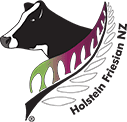High school students aren’t the only ones facing exams – about 50,000 dairy cows are undergoing their own rigorous assessments.
Trained inspectors are visiting hundreds of farms across New Zealand to assess each cow’s characteristics and traits.
“The data we collect is hugely important. It helps shape the genetics powering our multi-billion-dollar dairy sector,” said Holstein Friesian NZ inspector Tony O’Connor.
“We record a cow’s height and weight, and score her udder, legs, rump, capacity, condition and behaviour in the milking shed.”
The data is combined with milk production records and is used to evaluate the performance of the country’s top bulls.
Herd owning sharemilkers Dean and Aimee Perrett milk 260 cows on 73 hectares near Hawera in South Taranaki.
They’re one of around 400 Holstein Friesian breeders having their cows’ traits other than production (TOP) assessed this spring.
“It’s a really important information gathering exercise for our business. It gives us more data to help improve our mating decisions,” said Dean.
“Our cows have great udders, but the TOP assessments have highlighted rump angle as a weakness we need to consider when selecting bulls at mating.”
It’s believed changes in a cow’s rump angle can be partly blamed for a decline in her fertility and ability to get in calf quickly.
The Perrett’s have all their two-year-old heifers and a handful of older cows assessed under the TOP system each spring. They also herd test, which records a cow’s production, six times a year.
The coastal farm produced 110,000 kilograms of milksolids (kgMS) last season and is on track to produce 120,000 kgMS this year.
“Our herd sits in the top 1% for Holstein Friesians in New Zealand for BW (breeding worth),” said Dean.
“I’m trying to breed a cow that’s a solid producer with an udder built to last. Longevity is important.”
The Perrett’s have sought-after genetics with breeding companies seeking to contract mate almost 40 of their cows this season.
The couple didn’t mate the spring calving portion of their herd this year. They are in the process of transitioning to a fully autumn calving system.
“We started the transition in 2016 when we milked our cows which didn’t get in calf through the winter,” said Dean.
“This area is suited to winter milking. We can grow 30kgDM/ha/day of grass at that time of the year. Growth rates are as low as 5kgDM/ha/day in the summer.”
About 100 tonnes of palm kernel and 220 tonnes of homegrown maize silage are fed on a feed pad. They also buy in 80 tonnes of Proliq and harvest surplus grass for silage.
“Our goal is to lower our stocking rate and have cows producing close to 600 kilograms of milksolids each. That’s the benefit of having Holstein Friesians, you can produce more milk with fewer cows,” said Dean.
Holstein Friesian NZ TOP inspectors will assess more than 31,000 Holstein Friesian cows and two-year-old heifers this spring.
Registered pedigree animals receive a classification score which is awarded as part of the assessment. Last spring 413 Holstein Friesians achieved excellent or greater.
Other breeds of dairy cows will be assessed by inspectors from their breed society.



Add a Comment
You must be logged in to post a comment